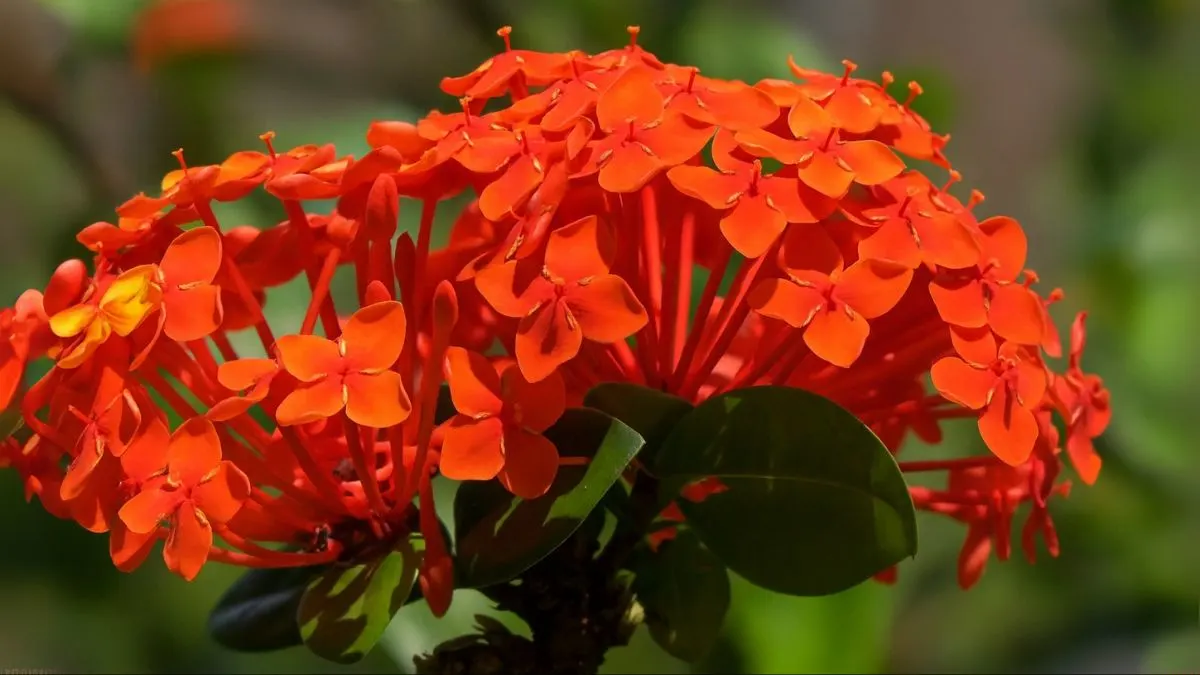If you’ve ever walked past a garden with fiery clusters of red, pink, orange, or yellow flowers, chances are you’ve spotted an Ixora. Known as the “flame of the woods,” this tropical shrub is a gardener’s delight. While many beginners think these plants are tricky, the truth is—Ixora plant care is negligible if you know the basics.
In this beginner-friendly guide, we’ll cover light, soil, watering, and tips to make Ixora flourish. Whether you live in Canada, the USA, or a tropical climate, you’ll be able to enjoy this showy plant.
Why Choose Ixora for Your Garden or Balcony?

- Adds vibrant color with year-round blooms.
- Compact, making it perfect for hedges, borders, or pots.
- Surprisingly low-maintenance once established.
- Great for both outdoor gardens and patios.
When I first bought my Ixora, I worried about meeting its tropical needs in a cooler climate. But by placing it in a container and moving it to a sunny spot, I discovered how adaptable it is.
Light Requirements
Lighting is the most important factor for Ixora.
- Ixora needs at least 6–8 hours of bright, direct sunlight daily.
- For maximum blooms, provide 8–10 hours of sunlight if possible.
- They do fine in partial light, but fewer flowers will form.
If you’re in North America and growing it indoors, place it near a south-facing window or supplement with grow lights. Remember, they are their happiest when they get 8–10 hours of direct to partial light in a day.
Also Read: Everything You Need to Keep Your Moon Valley Pilea Thriving
Soil Preferences
Ixora thrives in specific soil conditions.
- Use well-draining, slightly acidic soil.
- A mix of garden soil, peat moss, and sand works well.
- Avoid alkaline soil, as it can cause yellowing leaves.
Pro Tip: Add organic compost when planting to give it a nutrient boost.
Watering Ixora
Watering is where many gardeners make mistakes. it likes moisture but hates soggy roots.
- Keep the soil consistently moist, but avoid making it soggy.
- In summer, you may need to water every 2–3 days.
- In cooler months, reduce frequency but don’t let the soil dry out completely.
Remember: Keep it consistently moist but not soggy—this balance is the key to healthy roots and vibrant blooms.
Fertilizing Ixora
Feeding is essential if you want lush growth.
- Use a balanced fertilizer (10:10:10) every 2 weeks during the growing season.
- For richer flowers, opt for a phosphorus-rich fertilizer.
- Slow-release granules also work well for container plants.
Temperature and Humidity
Being a tropical plant, Ixora thrives in warmth.
- Best temperature range: 65–75°F (18–24°C).
- Protect from frost—bring indoors in colder climates.
- Prefers moderate to high humidity, so mist occasionally if indoors.
Also Read: Stachys Plant: Nature’s Soft Bandage With Healing Powers
Pruning and Maintenance
Another reason gardeners love it: minimal upkeep.
- Trim lightly after flowering to maintain shape.
- Remove dead or yellowing leaves to encourage new growth.
- Pruning helps stimulate branching, which means more flowers.
Common Problems and Solutions
- Yellow leaves: Often caused by alkaline soil—fix with acidic fertilizers.
- Few flowers: Likely due to insufficient light—ensure at least 6–8 hours of bright sunlight.
- Root rot: Caused by overwatering—check drainage.
Quick Ixora Care Guide
Aspect |
Requirement |
Light |
Provide 8–10 hours of sunlight |
Soil |
Well-draining, slightly acidic soil |
Watering |
Keep the soil consistently moist but not soggy |
Temperature |
65–75°F (18–24°C) |
Fertilizer |
Balanced fertilizer every 2 weeks |
Pruning |
Light trimming after flowering |
Personal Experience Growing Ixora
When I first brought home my Ixora in a small pot, I placed it on my balcony where it got only 3–4 hours of light. The leaves stayed green, but no flowers appeared. After learning that Ixora needs at least 6–8 hours of bright, direct sunlight daily, I moved it to a sunnier corner. Within weeks, clusters of bright red flowers appeared, and I realized Ixora is more about light and watering than anything else.
For gardeners in Canada or the USA, growing Ixora in containers is the best option. That way, you can bring them indoors in winter and still enjoy year-round beauty.
Also Read: Grow Bougainvillea Like a Pro: Bold Color, Fewer Problems!
Ixora Varieties Worth Trying
- Ixora coccinea – Most common, fiery red blooms.
- Ixora chinensis – Compact variety, great for pots.
- Ixora javanica – Taller, with orange-red flowers.
- Dwarf Ixora – Perfect for borders and small spaces.
Growing Ixora doesn’t need to be complicated. Whether you want to brighten up a patio, create a colorful hedge, or simply enjoy its tropical vibe indoors, it is an easy yet rewarding choice.
Don’t be afraid to experiment with container gardening. With the right sunlight and watering habits, it will thrive anywhere in the world.






